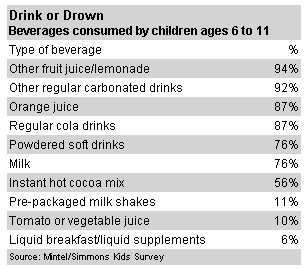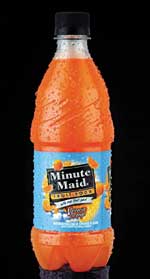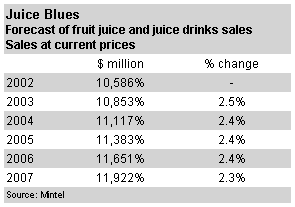
As Mintel International Group (Chicago) reports in its “Fruit Juice & Juice Drinks Market” report, the growth in bottled water and decline in carbonated beverages could mean a promising future for juices. Common wisdom has led the bottled water segment to new heights, as consumers have embraced the message of drinking eight 8-oz. servings of water daily. An extension of this philosophy easily could boost the juice and juice drinks market.
Water and fruit juices have the perception of healthfulness. Recent bottled waters have incorporated new flavors and functions, blurring the line between fruit juices, isotonics and water beverages.

Of those who had reduced soft drink consumption, 65% reported they now drink water, while 40% now substitute juice for some or all of those drinking occasions. Another 18% have opted instead for tea/ iced tea. All of these alternatives share a common attribute—stronger positive health benefits than soft drinks.
Nonetheless, sales of fruit juices and juice drinks dropped 2%—from $10.8 billion in 2001 to $10.5 billion in 2002. Juices account for 60% of sales, the remainder going to juice drinks. They have a high penetration of the U.S. consumer market, so the potential for future growth appears limited. In fact, Mintel projects less than 1% growth from 2002 to 2007, though this could be higher by “increasing per capita value” through more product introductions, and convincing consumers that juices are a convenient beverage.
A more promising future is likely in the diet drinks arena. Americans' battle with obesity and the rising rate of diabetes has resulted in a growing market for sugar-free, fruit-flavored beverages. In addition, considering the growing Hispanic population, Mintel believes some success could be found by introducing tropical juice flavors such as guava, mango and pineapple.

Declines may be expected, as the category's total sales flatten, but per capita consumption of fruit juice jumped nearly 30% between 1995 and 2000. In comparison, carbonated beverages enjoyed only a 3.8% growth, although bottled water jumped 58%.

A Successful Blend
Recent years did see a spurt of new products centering on fortification and blends. New offerings continue to combine existing additives in creative ways, but entirely new products are fairly rare, with no “breakout” products introduced in 2002.Major manufacturers have tried to invigorate the juice arena by breaking from what consumers might expect. Rather than the traditional juice successes, for example, Minute Maid (Houston) took its strong orange juice credentials into different flavors of lemonade. The approach did not go unnoticed.
Manufacturers found different combinations of two or more juice flavors a route to success. Some, in fact, experimented with vegetable juice combinations, primarily carrot. As Mintel discovered, juices have the perception as a healthful alternative to soda; therefore, parents are more inclined to purchase multiple flavors and formats of juice for children to consume throughout the day.
Fortification also has impacted the juice category, as single and combinations of vitamins and minerals are easy to find. Many juices now include calcium and/or antioxidant vitamins (A, C and E) and fiber. In fact, Mintel notes that calcium-fortified juices account for 30% of the growth among fortified juices.
Such a nutritious approach is wise, considering the majority of respondents (73%) to Mintel's research regard a juice's nutritional value as the most important factor in their determination of which juice to buy. Indeed, 61% of respondents to Mintel said they only buy juices designated as “100% juice.”
With such a high penetration of the market, the successful manufacturer would be well advised to convince consumers to buy multiple versions of juice, for consumption throughout the day. Nearly 90% of respondents to Mintel said they drink orange juice, and more than 80% drink other flavors of juice products. The most popular of these “others” were apple, grape and cranberry. The flavor consumed largely depends upon the presence of children.
Households with children were more likely to purchase grape, fruit punch, mixed blends and tropical juice flavors. However, almost 60% of respondents cited they were concerned about the sugar content of juices. Younger children have a clear preference for sweeter flavors, although those tastes change as they enter their teen years.
Parents' concerns over tooth decay—and other health concerns surrounding sugar—have prompted the introduction of “lighter” (low calorie/low sugar) varieties and more lines positioned as “natural.” While this trend has affected all segments, such a philosophy is expected to continue, and could have major implications in the development of pure juices naturally high in sugar. Manufacturers should consider this factor when competing against more healthful water drinks and attempting to encourage all-day consumption.
For more information on the report, “Fruit Juice & Juice Drinks Market,” contact Mintel International Group Ltd.; 213 W. Institute Place, Suite 208; Chicago, IL 60610; phone: 312-932-0400.
Website Resources
www.mintel.com— Mintel International Groupwww.minutemaid.com— Minute Maid
www.ultimatecitrus.com— A source for citrus information
pediatrics.about.com/library/weekly/ aa111401a.htm- How Much Juice is Too Much?, research by the American Academy of Pediatrics
